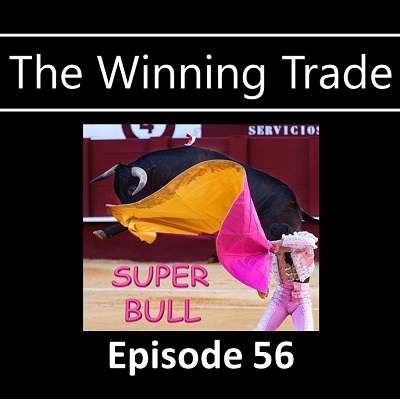
Unlocking the Trade with an 87% Win Rate! For those serious about achieving consistent profitability in options trading, understanding and mastering high probability strategies is key. Today, we’re diving into one such strategy that has proven its worth over the years: the Super Bull.
Click here or in the video to learn how!
Subscribe: YouTube
Subscribe: Soundcloud
Strategy Overview
The Super Bull strategy revolves around entering a bullish call vertical spread when the underlying asset is approximately 65 days from expiration. This timeframe is crucial as it allows for optimal leverage of time decay while mitigating the risk associated with directional movement in the market.
Key Components of the Super Bull Strategy
- Entry Criteria: When the asset is 65 days to expiration, a bullish call vertical spread is initiated. This involves buying a call option and simultaneously selling another call option at a higher strike price.
- Risk Management: Each trade typically requires a capital commitment of $1,000 to $1,200 per spread. The strategy aims for a profit equal to the initial capital, with an exit trigger set at a loss equivalent to the initial capital.
- Execution: Once entered, the strategy requires minimal intervention until the next cycle is 65 days from expiration. If the initial trade is profitable by the time the next cycle approaches, it is closed early to lock in gains. If not profitable, daily monitoring begins closer to expiration to capture profit opportunistically.
Performance Metrics
The Super Bull strategy boasts impressive performance metrics:
- Win Rate: Historically, the strategy has maintained an 87% win rate.
- Profit Potential: Since its inception in 2002 (backtested data available from 2011), the strategy has achieved a cumulative return of over 2,935.2%.
- Risk vs. Reward: On average, losses are typically three times the size of gains, which is crucial for managing drawdowns effectively.
Real-World Application
Let’s walk through an example:
- April Expiration: The trade is initiated when the asset price is $49.90, setting up a 20-point wide vertical spread.
- May Expiration: 65 days later, with the asset price at $49.23, the April position is closed for a profit of $523.
- June Expiration: The process repeats, with a new position initiated as the asset price stands at $50.28.
Continuous Improvement and Adaptation
Despite market conditions, the Super Bull strategy has proven resilient, adapting to different volatility environments while consistently delivering profitable results. Even during periods of heightened volatility, the strategy’s robust risk management principles ensure capital preservation and steady growth.
Conclusion
In conclusion, the Super Bull strategy exemplifies simplicity and effectiveness in options trading. By leveraging high probability setups and strict risk management, traders can potentially achieve substantial returns with minimized risk exposure.
If you’re interested in learning more about this strategy and other income-generating techniques, visit Locke In Your Success and explore our membership options today. Don’t miss out on the opportunity to elevate your trading journey with proven strategies.
Thank you for joining us on The Winning Trade. For more insights and updates, visit The Winning Trade and subscribe to our free Trading Performance Podcast. Your success is our priority, and we look forward to empowering your trading endeavors. Remember to like, share, and comment below to support our content and stay tuned for our next winning trade!
Continue to follow the Super Bull’s fantastic trade results with minimal attention. We support traders of the Super Bull and eleven other different options trading strategies each week by reviewing the movements of the trades in rotation through current market conditions during the Options Trading for Income by the Guidelines webinar. Consider joining us each week!
SEE OTHER SUPER BULL WINNING TRADE EPISODES!
Episode 126 – Super Bull Trading Strategy
Returns of these trades: The January trade returned about 59%, the February trade returned about 31.6%, the March trade returned about 62.1% for a combined total of about 153% in only 90 days!*
Episode 120 – Super Bull Trading Strategy
Returns of these trades: The September trade returned about 5.12%, the October trade returned about 1.26%, the November trade returned about 3.12% and the December trade returned about 47.2%. For a combined total of about 56.7% in 4 months!*

Episode 112 – Super Bull Trading Strategy
Returns of these trades: The May trade returned about 48.1%, the June trade returned about 23.6%, the July trade returned about 53.6% and the August trade returned about 37.6%. For a combined total of about 162% in 4 months!*
Episode 68 – Super Bull Trading Strategy
Returns of these trades: Trade 1 returned about 29.1%, Trade 2 returned about 19.1%, and Trade 3 returned about 1.6% for a total 49.8% on planned capital in 97 days.*
Episode 62 – Super Bull Trading Strategy
Returns of these trades: Trade 1 returned about 6.1%, Trade 2 returned about 51.6%, and Trade 3 returned about 46.6%.*
Episode 56 – Super Bull Trading Strategy
Returns of these trades: Trade 1 returned about 29.6%, Trade 2 returned about 24.1%, and Trade 3 returned about 53.1%.*
Episode 49 – Super Bull Trading Strategy
Returns of these trades: For the December 2020 expiration cycle we made a profit of $221 or 22.1%, for January 2021 a profit of $511 or 51.1%, and February 2021 a profit of $361 or 36.1%.
Episode 36 – Super Bull Trading Strategy
Returns of this trade: This Super Bull trade earned approximately 27.8% of planned capital in only 28 days!*
Episode 28 – Super Bull Trading Strategy
Returns of this trade: This Super Bull trade earned approximately 15.1% gain in 35 days through one of the fastest, largest point moves to the downside in history!*
Episode 19 – The Super Bull Strategy
Returns of this trade: This trade earned about $513 profit or about 51% of the $1,000 planned capital in just 31 days.*
Episode 7 – The Super Bull Strategy
Returns of this trade: This trade earned about $800 profit or about 80% of the example size 65 days.*
*The results shown are from real-time, hypothetical trades such as those shown in the Options Trading for Income weekly webinar. Simulated trades are believed to be represented as accurately as possible, however, live results may have been different. The result is shared as an example for educational purposes ONLY.













Leave a Reply
You must be logged in to post a comment.